
1 LEVERAGING CACFP FOR FARM TO EARLY CARE AND EDUCATION: GROWING WINS ACROSS EARLY CHILDHOOD AND FOOD SYSTEM SECTORS | JANUARY 2024 WWW.FRAC.ORG
Table of
Contents
BACKGROUND ................................................................................................................................................... 2
CACFP Fundamentals
.......................................................................................................................................................................................... 3
Farm to Early Care and Education Fundamentals ............................................................................................................................ 4
LEVERAGING CACFP FOR FARM TO ECE ............................................................................................ 5
How CACFP Can Be Used for Farm to ECE Activities .................................................................................................................... 5
Local Food Procurement .................................................................................................................................................................................... 6
Gardening .................................................................................................................................................................................................................... 6
Food, Nutrition, and Agriculture Education ........................................................................................................................................... 7
State-Level Coordination and Systems Change ..................................................................................................................................7
COMMUNITY ENGAGEMENT AND RESEARCH ................................................................................. 8
Group Interviews With Farm to ECE Partners ....................................................................................................................................... 8
Landscape Scan of Existing Literature and State-Level Websites ........................................................................................... 8
BARRIERS AND RECOMMENDATIONS FOR ACTION ..................................................................... 9
Enhance Child Care Provider Access to CACFP ................................................................................................................................10
Support CACFP Provider Farm to ECE Activities ...............................................................................................................................12
Bolster Local Food System Partner Access to CACFP Market Channels ........................................................................... 14
CONCLUSION .....................................................................................................................................................16
APPENDICES ......................................................................................................................................................17
Handwritten Receipt Template ...................................................................................................................................................................... 17
Garden Harvest Documentation Form Template ............................................................................................................................... 17
Practical Resources to Help Support and Implement Farm to ECE Activities While Leveraging CACFP ........... 18
Semi-Structured Group Interview Guide .................................................................................................................................................18
Characteristics of State-Level CACFP and Farm to ECE Websites and Practices .........................................................19
Acknowledgments
The Food Research & Action Center (FRAC)
gratefully acknowledges the major dedicated
support of the Farm to Early Care and Education
work provided by the W.K. Kellogg Foundation.
This report was prepared by Katie Jacobs and
Lisa Hofmann.
About FRAC
The Food Research & Action Center (FRAC)
improves the nutrition, health, and well-
being of people struggling against poverty-
related hunger in the United States through
advocacy, partnerships, and by advancing
bold and equitable policy solutions. For more
information about FRAC, or to sign up for FRAC’s
e-newsletters, go to www.frac.org.

2 LEVERAGING CACFP FOR FARM TO EARLY CARE AND EDUCATION: GROWING WINS ACROSS EARLY CHILDHOOD AND FOOD SYSTEM SECTORS | JANUARY 2024 WWW.FRAC.ORG
local and regional farmers, ranchers, dairies, food
processors, and distributors through opening another
market channel for their products. U.S. Department of
Agriculture (USDA) encourages the use of local food as
a means to enhance CACFP operations.
7
Despite the positive impacts that are compounded
when CACFP and Farm to ECE are leveraged
together, too few child care sites operationalize each
of these strategies. This underutilization is due to a
variety of barriers. CACFP and Farm to ECE systems
changes — changes to processes, policy, regulations,
environments, and available resources — can help
alleviate these barriers.
F
ood insecurity is a pervasive and multidimensional
issue that requires creative solutions across
sectors and across levels of influence. We cannot end
hunger without tackling the structural drivers of food
insecurity and injustice.
Both the Child and Adult Care Food Program (CACFP)
and Farm to Early Care and Education (Farm to ECE)
initiatives work across sectors to address some of the
social determinants that contribute to food insecurity,
including inadequate access to quality early care
and education, poor health outcomes, economic
instability, and under-resourced food systems. As a
result of systems of oppression like systemic racism,
stark disparities exist by race, ethnicity, income, and
geography in rates of food security and its structural
drivers. CACFP and Farm to ECE initiatives combat
these disparities and can improve equitable access to
fresh, healthy foods for young children.
CACFP and Farm to ECE activities have the potential
to support each other and compound their respective
positive impacts.
CACFP Supports Farm to ECE: It can often be
prohibitively expensive for child care providers to
purchase local foods for use in meals served to the
children in their care. Use of CACFP, as a mandatory
federal funding mechanism, is a sustainable
funding source for Farm to ECE activities. The most
recent National Farm to Early Care and Education
Survey demonstrates this relationship through a
statistically significant association between sites
that received CACFP funding and sites that served
local foods, including the percentage of local foods
they purchased.
1
Additionally, leveraging CACFP is
documented as a recommendation to strengthen Farm
to ECE in multiple publications.
2,3,4
Farm to ECE Supports CACFP: Farm to ECE activities
can support the impact of CACFP by increasing the
actual intake of healthy foods served in CACFP. Farm to
ECE has been shown to increase children’s willingness
to try new produce and increase their fruit and
vegetable intake.
5,6
Farm to ECE increases the positive
impact that CACFP has on the community by supporting
The report builds on the CACFP information
included in the Enhancing Young Children’s Access
to Local Foods and Farm to ECE: Federal Funding
Opportunities Guide. This guide provides functional
descriptions of actionable and timely funding
streams, including an overview of the funding
eligibility requirements, allowed uses, timeline, flow
of funds, and strategies for action. The guide also
highlights case examples of how entities across the
country are creatively leveraging funding streams
for Farm to ECE. The purpose of this guide is to
prepare and position Farm to ECE partners to
eectively apply for funding.
Background
CACFP Fundamentals
Farm to Early Care and
Education Fundamentals
Enhancing Young Children’s Access to Local Foods and Farm to ECE:
Federal Funding Opportunities
February 2022 | www.frac.org | www.policyequity.com | www.asphn.org | www.farmtoschool.org
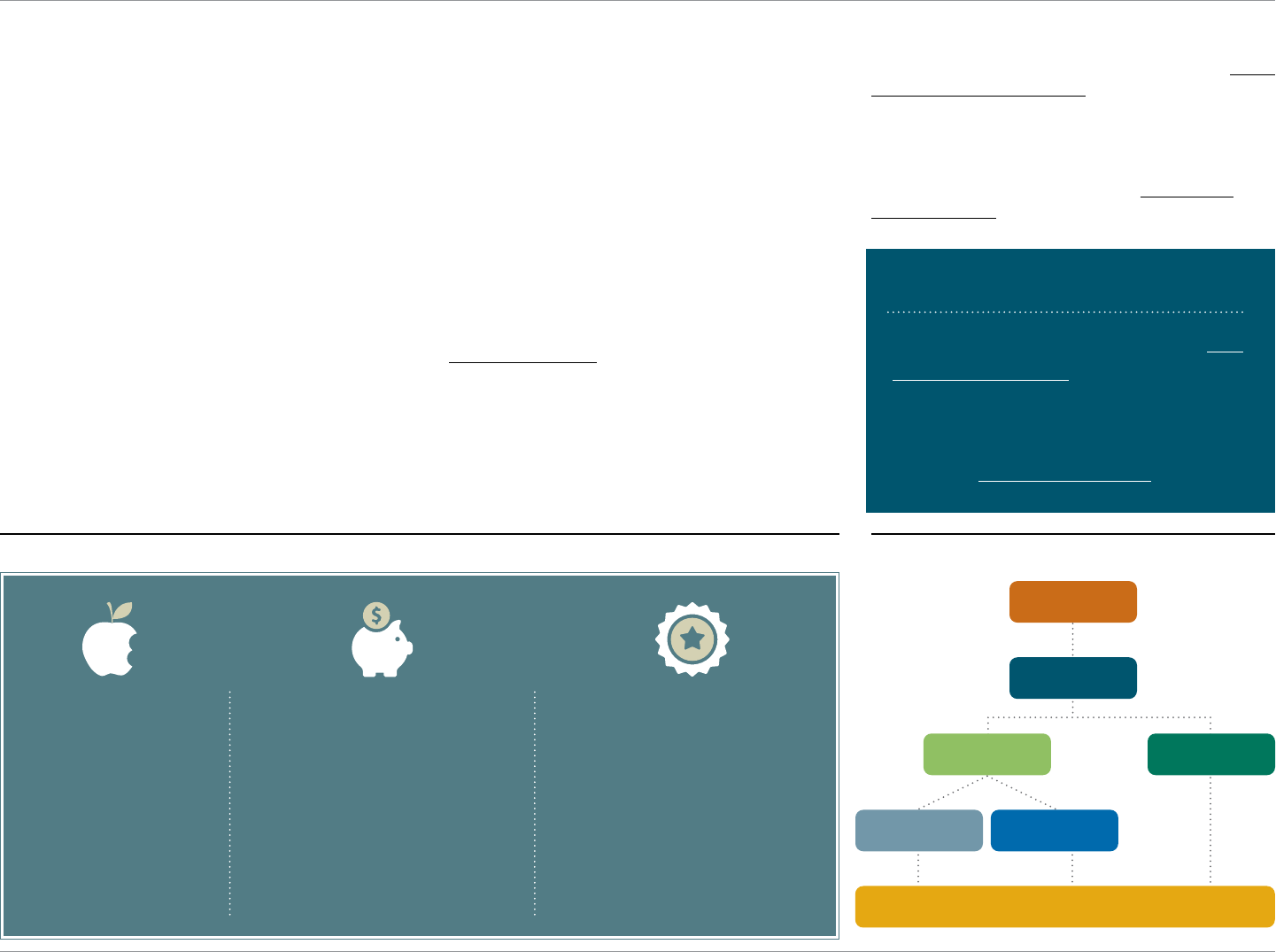
3 LEVERAGING CACFP FOR FARM TO EARLY CARE AND EDUCATION: GROWING WINS ACROSS EARLY CHILDHOOD AND FOOD SYSTEM SECTORS | JANUARY 2024 WWW.FRAC.ORG
To explore and promote the systems changes
necessary to expand and strengthen the role of CACFP
in supporting Farm to ECE activities, the Food Research
& Action Center (FRAC), funded by the W.K. Kellogg
Foundation, conducted a series of interviews with
key national, state, and local CACFP and Farm to ECE
partners, and performed a literature review of existing
materials. Through qualitative and quantitative analysis,
this report identifies key barriers, recommended
actions, and best practices for accessing and
leveraging CACFP for Farm to ECE activities. This work
is possible through previous investments of the W.K.
Kellogg Foundation that built a vibrant network of Farm
to ECE programs that enabled sharing of best practices
and tools for expanding the model across the country.
The report is intended to be used by CACFP and Farm
to ECE partners across federal, state, and local levels
to help create systems changes to and support direct
implementation of CACFP and Farm to ECE. Partners in
this goal include policy and regulation decision-makers,
state agencies, CACFP sponsors, child care providers,
local farmers and ranchers, regional food hubs, and
other food system sector partners.
CACFP FUNDAMENTALS
The Child and Adult Care Food Program (CACFP) is
a federally funded child nutrition program that pays
for nutritious meals and snacks served to eligible
children who are enrolled at participating child care
centers, family child care homes, Head Start programs,
afterschool programs, and emergency shelters. Each
day, 4.7 million children receive nutritious meals and
snacks through CACFP.
8
In fiscal year 2022, 1.5 billion
meals were served to eligible children through the
program. CACFP is a vital health, economic, and child
care quality support for communities (Figure 1).
CACFP is administered at the national level by the U.S.
Department of Agriculture Food and Nutrition Service
(FNS). Within each state, CACFP is administered by
a CACFP state agency, often the state’s Department
of Education or another agency designated by the
state. Child care homes and centers can participate in
CACFP through a sponsoring organization. Child care
centers can alternatively choose to apply directly to the
state agency and operate as an independent center
(Figure 2). Participating child care homes and centers
receive reimbursement funding for up to two meals
BACKGROUND
Figure 1: CACFP Provides Vital Support for Communities
9,10,11,12,13,14,15,16,17,18,19
Figure 2: CACFP’s Administrative Structure
` ENSURES children receive
nutritious meals and snacks
while in child care
` REDUCES food insecurity
` PROMOTES healthy growth
` BOOSTS learning and
development
HEALTH BENEFITS
` SUPPORTS families’ ability to work
` SUPPORTS jobs in child care
` SUPPORTS local economies and local
food producers through the purchase
of healthy foods at grocery stores,
farmers markets, and other local food
procurement sources
` MAKES child care more aordable for
families with low incomes
ECONOMIC VALUE
(breakfast, lunch, or supper) and one snack or one meal
and two snacks served to each eligible child, each day.
Current reimbursement rates can be found at the USDA
CACFP Reimbursement Rates website.
Eligible participants in child care homes and centers
include children age 12 and younger, migrant children ages
15 and younger, and persons with disabilities of any age.
For more information on CACFP, visit USDA FNS’s
CACFP webpage.
WANT TO PARTICIPATE IN CACFP?
Getting started with CACFP is easy. Visit your
state’s CACFP website to learn how to apply
and to find a sponsoring organization.
You can also find a sponsor by visiting
info.cacfp.org/sponsor.
` BOOSTS and helps stabilize child care
providers’ income
` STRENGTHENS the quality of early care
services
` RECOGNIZED as a quality indicator,
with many states currently awarding
Quality Rating and Improvement System
points for participating in CACFP and/or
following CACFP meal patterns
QUALITY CHILD CARE SUPPORT
USDA
State Agencies
Children
Family Child Care
Providers
Sponsored
Centers
Sponsors
Independent
Centers

4 LEVERAGING CACFP FOR FARM TO EARLY CARE AND EDUCATION: GROWING WINS ACROSS EARLY CHILDHOOD AND FOOD SYSTEM SECTORS | JANUARY 2024 WWW.FRAC.ORG
FARM TO EARLY CARE AND
EDUCATION FUNDAMENTALS
Farm to Early Care and Education initiatives are
community-based and include activities to support
young children’s connections to fresh and healthy local
foods and their engagement with local agriculture. Farm
to ECE activities can vary in scale and scope and take
place in many ECE settings, including family child care
homes, child care centers, preschools, and Head Start/
Early Head Start. Farm to ECE initiatives are multisectoral,
working across food, agriculture, health, nutrition, and
BACKGROUND
Figure 3: Core Elements of Farm to ECE Activities
early care and education systems. Using the National
Farm to School Network’s framework, child care
programs engaging in Farm to ECE conduct activities
in at least one of three core elements: (1) local food
purchasing, (2) gardening, and (3) food, nutrition, and
agriculture education (Figure 3).
20
Examples of activities
within each core element are included in the figure.
For more information on Farm to ECE, explore the
W.K. Kellogg Foundation’s Farm to Early Care and
Education Partner Toolkit and visit the National Farm to
School Network’s Farm to ECE webpage.
Source: Modeled from the National Farm to School Network’s Core Elements of Farm to School framework, farmtoschool.org.
GARDENS PURCHASING
EDUCATION
LOCAL FOOD PURCHASING
` PROCURING foods for taste
tests from a local farmers
market
` PURCHASING local, culturally
relevant foods for use in meals
and snacks
GARDENS
` PLANTING, watering,
and harvesting in an
on-site garden
` TASTE TESTING foods
grown in a garden
FOOD, NUTRITION, AND
AGRICULTURE EDUCATION
` VISITING a local farm or
community garden
` CONDUCTING a cooking
demonstration using local food

5 LEVERAGING CACFP FOR FARM TO EARLY CARE AND EDUCATION: GROWING WINS ACROSS EARLY CHILDHOOD AND FOOD SYSTEM SECTORS | JANUARY 2024 WWW.FRAC.ORG
Leveraging CACFP
for Farm to ECE
How CACFP Can Be Used for
Farm to ECE Activities
1. Local Food Procurement
2. Gardening
3. Food, Nutrition, and
Agriculture Education
4. State-Level Coordination
and Systems Change
HOW CACFP CAN BE USED FOR
FARM TO ECE ACTIVITIES
CACFP can support all three core elements of
Farm to ECE activities by providing resources
and defraying the monetary costs associated with
local food procurement; garden development and
maintenance; and food, nutrition, and agriculture
education. CACFP state administrative expense (SAE)
funds can also be used to support systems changes
that strengthen and expand Farm to ECE. Figure 4
summarizes the ways in which Farm to ECE can be
leveraged for Farm to ECE activities.
Figure 4: Snapshot of Ways CACFP Can Be Leveraged for Farm to ECE Activities
CACFP can be leveraged to support multiple core elements of Farm to Early Care and Education.
EDUCATION
Garden products can be used for nutrition
education or taste testing. Providers can
use USDA Team Nutrition resources for
agricultural and nutrition education lessons.
STATELEVEL COORDINATION
CACFP state agencies can use state administrative expense funds to support Farm to ECE
coordination and other activities. Funds can be used for state-level activities, including:
GARDENING
As long as produce grown is used as part of reimbursable meals or
nutrition education, CACFP can be used for gardening items including:
PROCUREMENT
CACFP can be used to purchase local foods from:
1 2
43
` Farmers Markets
` Food Hubs
` Seeds
` Fertilizer
` Produce state-
level Farm to
ECE guidance
materials
` Community
Supported
Agriculture
Models
` Watering Cans
` Rakes
` Create Farm to ECE
coordinators that provide
state-level training and
technical assistance
` Conduct statewide
trainings and organize
` Other Food
Vendors
` Garden Plot Rentals
statewide meetings to
disseminate program
information and encourage
sharing of best practices
` Collaborate on regional
Farm to ECE eorts
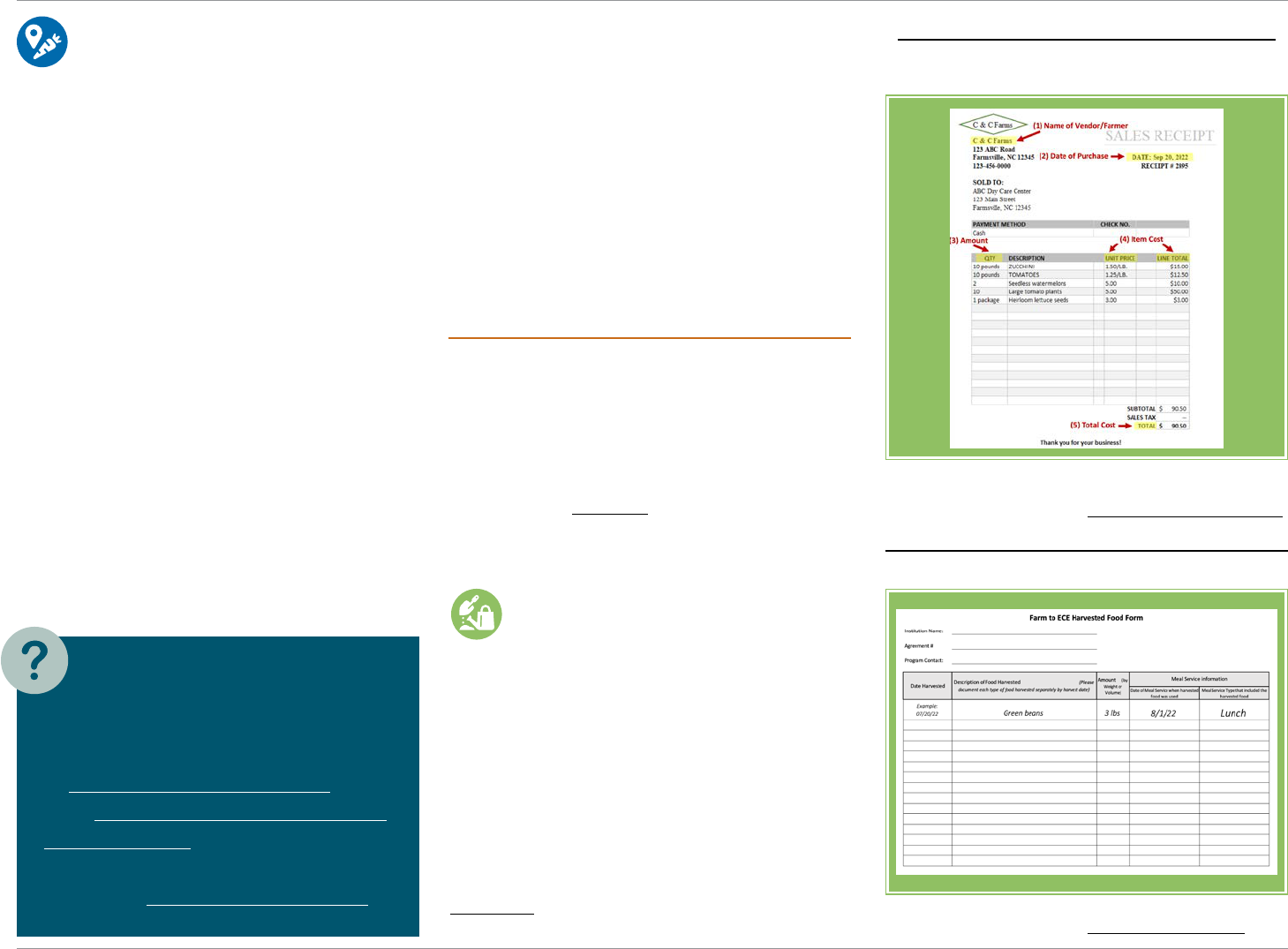
6 LEVERAGING CACFP FOR FARM TO EARLY CARE AND EDUCATION: GROWING WINS ACROSS EARLY CHILDHOOD AND FOOD SYSTEM SECTORS | JANUARY 2024 WWW.FRAC.ORG
1. LOCAL FOOD PROCUREMENT
Local foods can be used in any component of
a CACFP reimbursable meal, from fruits and
vegetables, to milk, cheese, beans, eggs, grains, and meat.
Local foods can be procured from a variety of sources
including farmers, ranchers, dairies, food hubs, gardens,
farmers markets, distributors, and community supported
agriculture vendors. Grocery stores may also stock local
foods. CACFP providers can consider procuring sustainably
grown local foods to the extent they are able to further
compound the positive impacts of local food procurement.
When buying local foods, CACFP providers must operate
under their regular procurement rules. Procurement rules
dier between CACFP institutions that participate in the
program directly through the state agency (e.g., sponsors
and independent centers) versus CACFP facilities that
participate through a sponsoring organization (e.g., family
child care homes and sponsored centers).
21
CACFP
institutions must follow federal procurements rules.
When an invitation for bid (also known as, IFB) or request
for proposal (RFP) is required under these rules, CACFP
institutions can apply a geographic preference to their
specifications for unprocessed foods.
CACFP providers must have receipts for all foods
purchased that are used in reimbursable meals. Farmers
markets or farm stands may not typically print receipts, and
in these cases, CACFP providers can ask for handwritten
receipts. Handwritten receipts are cited by USDA as an
acceptable form of documentation
23
for items purchased
as long as the receipt has: (1) date of purchase, (2) name
of vendor/farmer, (3) item cost per unit, (4) amount of food,
and (5) total cost. Figure 5 outlines an example of a farm
receipt from the North Carolina Department of Health and
Human Services. Appendix 1 has a blank receipt template
that CACFP providers can download, print, and use
when only handwritten receipts are available.
2. GARDENING
24,25
CACFP can help oset the costs of starting and
maintaining a garden at the ECE site. CACFP
funds can be used for necessary gardening supplies as
long as the produce grown in the garden will be used
as part of reimbursable meals or for nutrition education
activities. Allowable garden items include garden plot
rentals, seeds, soil, fertilizer, watering cans, and garden
tools like rakes and shovels.
CACFP providers must document the types and amount
of foods harvested in the garden before the food is
used in a CACFP reimbursable meal. Figure 6 outlines
an example form to document this information from
the Georgia Department of Early Care and Learning.
Appendix 2 provides a template that CACFP providers
can download and use in their harvest documentation.
LEVERAGING CACFP FOR FARM TO ECE
“Institutions participating in [CACFP]
may apply a geographic preference when
procuring unprocessed locally grown or
locally raised agricultural products. When
utilizing the geographic preference to procure
such products, the institution making the
purchase has the discretion to determine the
local area to which the geographic preference
option will be applied.”
22
— USDA FNS 2011 Final Rule on Geographic
Preference Option in Child Nutrition Programs
(7 CFR 226.22(n)(1))
WHAT IS LOCAL?
CACFP does not define “local.” CACFP
providers can decide what definition of local
makes the most sense for their specific context.
The Defining and Finding Local Foods section
of the USDA Procuring Local Food for Child
Nutrition Programs oers considerations for
how to define local. For assistance finding local
foods, visit USDA’s Local Food Directory.
Source: North Carolina Department of Health and Human Services, Division of
Child and Family Well-Being, Community Nutrition Services Section, Child and
Adult Care Food Program. Available at: ncdhhs.gov/sample-farm-receipt/open
Source: Georgia Department of Early Care and Learning. (2022). CACFP, Farm to
ECE Harvested Food Form. Available at: decal.ga.gov/bfts/FormList.aspx.
Figure 5: Example Handwritten Food Purchase
Receipt Template
Figure 6: Example Garden Harvest Documentation Form

7 LEVERAGING CACFP FOR FARM TO EARLY CARE AND EDUCATION: GROWING WINS ACROSS EARLY CHILDHOOD AND FOOD SYSTEM SECTORS | JANUARY 2024 WWW.FRAC.ORG
LEVERAGING CACFP FOR FARM TO ECE
3. FOOD, NUTRITION, AND AGRICULTURE
EDUCATION
26,27
CACFP also supports food, nutrition, and
agriculture education by osetting the costs to
grow food that is used in taste testing, cooking
demonstrations, and/or other educational activities.
CACFP funds can be used for gardening supplies
when the produce grown in the garden is used for
educational activities or in a reimbursable meal.
Additionally, CACFP providers can use USDA Team
Nutrition resources for agricultural and nutrition
education lessons and curriculums.
4. STATELEVEL COORDINATION AND
SYSTEMS CHANGE
USDA FNS provides funds to CACFP state
agencies annually to administer CACFP. These
funds are called state administrative expense funds.
Generally, SAE funds are allowed to be used for
state-level salaries and benefits, travel expenses, and
costs associated with providing training and technical
assistance to CACFP providers and sponsors.
28
CACFP state agencies can use some of their SAE
funds to support Farm to ECE coordination, systems
change, and other activities. Funds can be used for
state-level activities including:
` PRODUCING state-level Farm to ECE guidance
materials,
` EMPLOYING Farm to ECE coordinators that provide
state-level training and technical assistance,
` CONDUCTING statewide trainings and organizing
statewide meetings to disseminate program information
and encourage sharing of best practices, and
` COLLABORATING on regional Farm to ECE eorts
like multistate conferences, training, and site visits.
Appendix 3 provides a list of practical resources to
help support and implement Farm to ECE activities
while leveraging CACFP.
POLICY, GUIDANCE, AND RESOURCES ON ALLOWABLE
CACFP USES FOR FARM TO ECE ACTIVITIES
WEBPAGE: USDA Farm to CACFP
FACT SHEET: Farm to Preschool: Local Food and Learning in Early Child Care and Education Settings
POLICY MEMO: Local Foods in CACFP
GUIDE: Procuring Local Foods for Child Nutrition Programs
“Beyond Lunch: Buying Local Foods for Summer and Childcare Programs”
GUIDE: Local Food for Little Eaters: A Purchasing Toolbox for the Child and Adult Care Food Program
POLICY MEMO: Use of State Administrative Expense (SAE) Funds to Support Farm to ECE
POLICY MEMO: Procuring Local Meat, Poultry, Game and Eggs for Child Nutrition Programs
USDA FNS GUIDANCE DOCUMENT: Financial Management CACFP — FNS Instruction 796–2, Revision 4
WEBPAGE: USDA Local Food Directories
FACT SHEET: USDA Geographic Preference: What It Is and How to Use It
WEBPAGE: Food Buying Guide for Child Nutrition Programs

8 LEVERAGING CACFP FOR FARM TO EARLY CARE AND EDUCATION: GROWING WINS ACROSS EARLY CHILDHOOD AND FOOD SYSTEM SECTORS | JANUARY 2024 WWW.FRAC.ORG
Community
Engagement and
Research
Group Interviews With
Farm to ECE Partners
Landscape Scan of Existing Literature
and State-Level Websites
T
o better understand the barriers, facilitators,
recommendations, and promising practices to
leveraging CACFP for Farm to ECE, the Food Research
& Action Center engaged CACFP and Farm to ECE
experts in group interviews and online surveys. FRAC
conducted a landscape scan of CACFP state agency
and state-level Farm to ECE websites and performed a
structured review of existing peer-reviewed and grey
literature resources.
GROUP INTERVIEWS WITH FARM TO
ECE PARTNERS
FRAC interviewed over 75 partners from across the
CACFP and Farm to ECE landscape at the federal, state,
and local levels. Interviews lasted one hour, and were
conducted via Zoom. Partners included representatives
from USDA FNS, CACFP state agencies, CACFP
sponsors, CACFP providers, including Head Start,
child care educators, farmers associations, farmers
unions, food distribution vendors, food policy councils,
child care associations, agriculture/food advocacy
organizations, academic institutions, Farm to ECE state
agencies, Extension, child advocate organizations,
state departments of agriculture, and USDA Farm to
School program representatives. At the state level,
CACFP and Farm to ECE partners in 11 states spanning
the U.S. were engaged, including:
Alabama
Georgia
Iowa
Louisiana
Michigan
Mississippi
New Mexico
North Carolina
Pennsylvania
Washington
Wisconsin
Using a semi-structured interview guide, interviewees
were asked about their experiences with CACFP
and leveraging it for Farm to ECE. Questions aimed
to gather information on barriers and facilitators to
participating in CACFP and Farm to ECE, existing
resources for and ways in which CACFP is being used
for Farm to ECE, and what additional or changes to
resources, practices, or policies can increase access to
Farm to ECE activities using CACFP at the federal, state,
and local levels. Appendix 4 outlines questions within
the semi-structured interview guide. Interviews were
recorded, transcribed, and coded to uncover themes
for each state. The results of the synthesized interview
feedback themes are presented in the “Barriers and
Recommendations for Action” section within this report.
LANDSCAPE SCAN OF EXISTING
LITERATURE AND STATE-LEVEL
WEBSITES
In spring 2023, we conducted a structured scan of all
CACFP state agency websites for communications,
practices, and policies related to Farm to ECE, including
the mention of Farm to ECE on the CACFP state agency
website. We also cataloged characteristics of state-level
Farm to ECE/Farm to CACFP webpages as they related
to CACFP, where available. Characteristics assessed
include the existence of a state-level Farm to ECE website,
mention of CACFP on that site, and the presence of
resources for farmers or food system partners.
In addition to a website scan, we distributed an online
survey to all CACFP state agencies. The survey was
completed by state agency directors or other sta
members as delegated by the director. We received
responses from 46 state agencies and the District of
Columbia. State agencies were asked about use of
State Administrative Expense funds for Farm to ECE
activities, their current Farm to ECE initiatives, and what
support/changes would help increase Farm to ECE
activities leveraging CACFP in their state. Appendix 5
provides tabulated state-by-state results of the website
scan and survey.
Beyond resources available on CACFP state agency
websites, we also conducted a structured scan for
existing peer-reviewed and grey literature resources that
relate to leveraging CACFP for Farm to ECE. Resource
types include academic articles, USDA guidance and
resources, research and recommendation reports, case
studies, reporting tools, briefs, and infographics.

9 LEVERAGING CACFP FOR FARM TO EARLY CARE AND EDUCATION: GROWING WINS ACROSS EARLY CHILDHOOD AND FOOD SYSTEM SECTORS | JANUARY 2024 WWW.FRAC.ORG
Barriers and
Recommendations
for Action
Enhance Child Care Provider
Access to CACFP
Support CACFP Provider
Farm to ECE Activities
Bolster Local Food System Partner
Access to CACFP Market Channels
O
ur community engagement and research activities
bolstered the understanding that accessing
CACFP and leveraging it for Farm to ECE activities
has known challenges, but that there are tangible
pathways forward and many examples of successful
initiatives/facilitators that provide models/evidence for
action. Based on the aggregate research findings, we
have developed a set of multilevel and multisectoral
recommendations that aim to support access to CACFP
and Farm to ECE activities for sponsors, providers, and
the children they serve. Recommendations for action
fall into three main themes:
` Enhance Child Care Providers’ Access to CACFP
` Support CACFP Providers’ Farm to ECE Activities
` Bolster Local Food System Partners’ Access to
CACFP Market Channels
Successfully improving access to CACFP and its
use for Farm to ECE activities includes ensuring that
implementation of the following recommendations
center equity principles and include the input and
direction of communities most impacted by food
insecurity. Implementation should also be informed
by stakeholders that will be impacted by the
recommended change. Recommendations should be
implemented in ways that actively advance equity and
do not have unintended negative consequences and/
or increase disparities in access.
Recommendations are tagged/characterized by the
stakeholder level at which they can be actualized,
ranging from congressional policy changes, USDA
regulations and guidance creation, CACFP state
agency policy and implementation options,
CACFP sponsoring organization activities, child
care providers, farmers and other food system
partners, and community organization advocates.
These recommendations are grounded and
contextualized in the related barriers, facilitators,
and promising practices elucidated from our
research. Recommendations span change to
processes, policy, regulations, environments, and
available resources, and are in line with preexisting
recommendation reports.
“We have to focus more on understanding
where we are in terms of equity and
where dierent centers that are serving
dierent demographics of children are
located. In dierent areas, automatically,
not only are there dierent resources
but dierent food costs too. Until we
change those systemic problems which
are related to food cost or low access and
things like that we have to make up for it,
so that centers where it's harder for them
to purchase locally and more costly for
them to do so are given more resources
to make up for that fact.”
— Group Interview participant
CHILD CARE
PROVIDERS
CONGRESS U.S.
DEPARTMENT OF
AGRICULTURE
CACFP STATE
AGENCIES
COMMUNITY
ORGANIZATION
PARTNERS
FARMERS/
FOOD SYSTEM
PARTNERS
STAKEHOLER LEVELS
CACFP
SPONSORING
ORGANIZATIONS
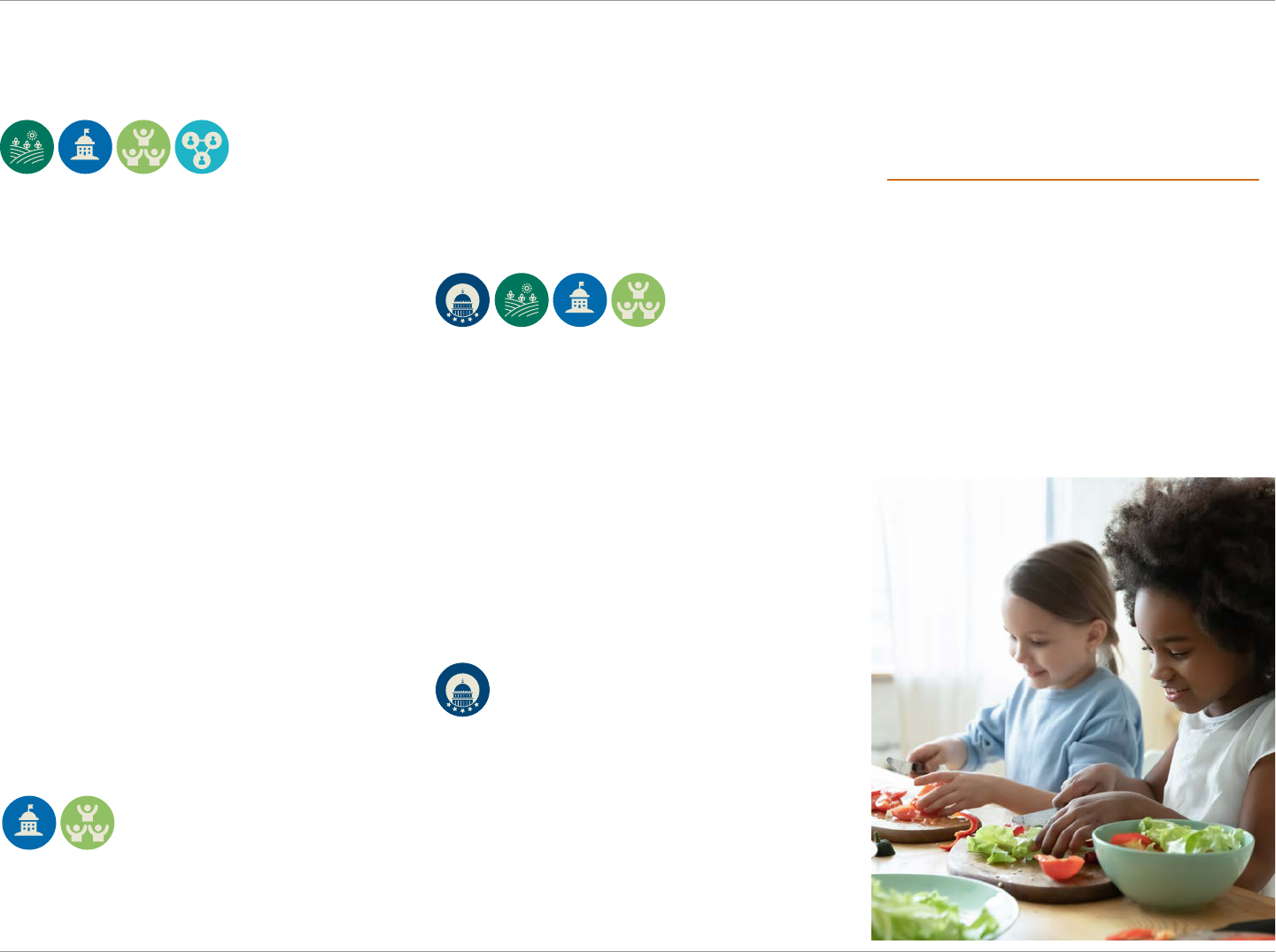
10 LEVERAGING CACFP FOR FARM TO EARLY CARE AND EDUCATION: GROWING WINS ACROSS EARLY CHILDHOOD AND FOOD SYSTEM SECTORS | JANUARY 2024 WWW.FRAC.ORG
ENHANCE CHILD CARE PROVIDER
ACCESS TO CACFP
1. PROMOTE AWARENESS OF CACFP
WITH TAILORED COMMUNICATIONS
CACFP stakeholders should use existing outreach
materials, or develop/modify their own materials, to
promote awareness of CACFP among child care
providers and to increase their desire and ability to
participate in the program. Outreach materials can
be intended to directly promote CACFP to child care
providers or they can be intended to educate partner
organizations, like Child Care Resource and Referral
organizations and Child Care Licensing agencies, on
CACFP and how these partners can in turn connect
child care providers to CACFP.
Any promotional or educational outreach
communications should be tailored to the needs of the
child care providers in the community, including being
in the preferred language of the child care provider.
Pilot testing or co-developing outreach messaging with
current CACFP providers is an eective way to help
ensure that the messaging resonates with the intended
audience. CACFP outreach channels can include flyers,
newsletters, social media posts and ads, and websites.
Helpful resources for partner organizations to begin
supporting child care providers’ access to the program
include toolkits, guides, fact sheets, and manuals that
describe CACFP and the process child care providers
can take to apply to participate in the program.
2. MAXIMIZE ACCESSIBILITY OF TRAININGS FOR
CACFP SPONSORS AND PROVIDERS
Maximizing the accessibility of CACFP training for
sponsors and providers is crucial. Group interview
participants emphasized that this can be achieved
through flexible training schedules, including online
BARRIERS AND RECOMMENDATIONS FOR ACTION
options to reduce travel and time burdens, and oering
trainings on nights and weekends when providers
are less likely to be caring for children. Training and
accompanying materials should be oered in multiple
languages. Simplified, bite-sized training modules can
help providers and sponsors better understand and
retain information as group interview participants noted
that long training manuals can deter participation.
3. STREAMLINE PROGRAM REQUIREMENTS, REDUCE
PAPERWORK, AND MAXIMIZE TECHNOLOGY TO
IMPROVE PROGRAM ACCESS
All states interviewed discussed the paperwork cost
burden associated with CACFP participation. Thankfully,
there are many ways to streamline CACFP operations
and increase its reach among families with low incomes.
Streamlining CACFP can be achieved by modernizing
applications via technology, eliminating the need for
“normal days and hours” on forms, adopting electronic
data collection, allowing options for remote visit systems
that comply with federal CACFP standards, enabling
direct certification across all states, and improving
the serious deficiency process to help sponsoring
organizations resolve issues more eectively.
4. IMPROVE CACFP REIMBURSEMENTS FOR
CHILD CARE PROVIDERS
Cost is one of the most cited barriers to providing the
healthier foods required by CACFP and is even more so
cited as a barrier for purchasing local foods. Increasing
the availability and consumption of fruits and vegetables,
whole grains, and lower-fat dairy products among young
children in child care is essential to promote healthy
development and growth at exactly the time — early
childhood — when it can have the most long-term
eects. This eort needs to be supported by adequate
meal reimbursements for child care providers.
4a. Allow child care homes and centers the
option of serving an additional meal service, as
was previously allowed. Established through
national child care standards, grounded in the
latest nutrition and child development science,
young children require frequent, small, healthy
meals and snacks throughout the day. Considering
the extended hours many children spend in care
due to their parents’ long workdays and commutes,
child care providers play a crucial role in fulfilling
most of these children’s nutritional needs. Formerly,
child care providers were eligible to serve up to
“I think my biggest thing would be the
paperwork, just limiting how much time
is consumed with it from kitchen sta who
are already working their butts o.”
— Group Interview participant
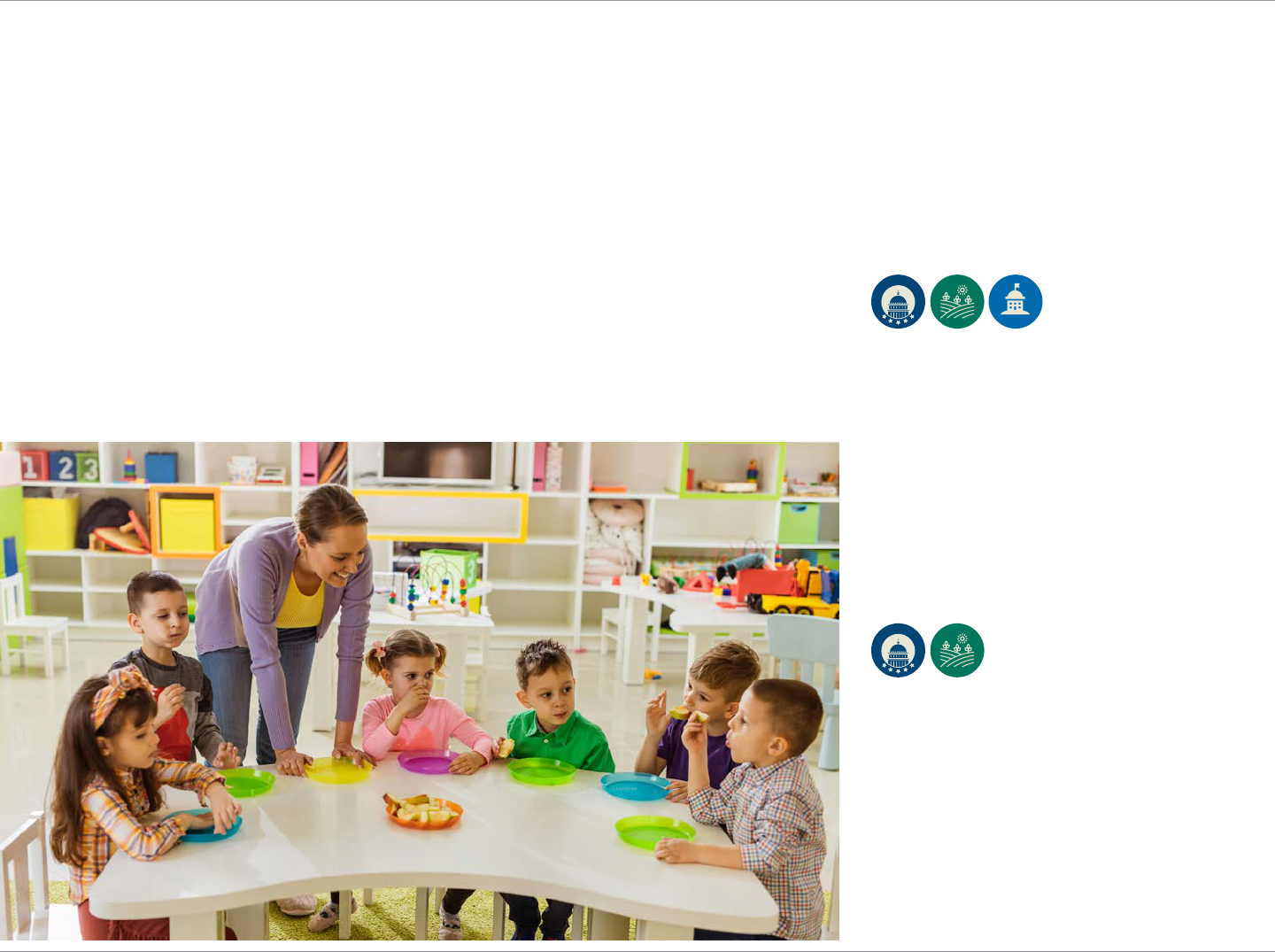
11 LEVERAGING CACFP FOR FARM TO EARLY CARE AND EDUCATION: GROWING WINS ACROSS EARLY CHILDHOOD AND FOOD SYSTEM SECTORS | JANUARY 2024 WWW.FRAC.ORG
four meal services, typically including two meals
and two snacks. However, Congress reduced
this provision to save on the budget, negatively
impacting children’s nutrition and health and
weakening child care. Reinstating full CACFP
support for all necessary meals and snacks is vital.
4b. Eliminate the area eligibility test to
streamline access to healthy meals for young
children in family child care homes. Under the
area eligibility waiver enacted during the COVID-19
pandemic, all family child care homes qualified
for the highest CACFP meal reimbursement rate.
This waiver eliminated the usual area eligibility
requirement that requires a child care home to be
in an area with a 50 percent low-income threshold
to receive the higher reimbursement rate. This
threshold is not an eective mechanism because
it misses many providers serving children from
households with low incomes. This is especially
BARRIERS AND RECOMMENDATIONS FOR ACTION
true in rural and suburban areas. In addition, the
area eligibility test completely bypasses providers
and families struggling in high cost-of-living areas.
Permanently eliminating the area eligibility test
would bring more child care providers who serve
children from households with low incomes into
CACFP, and many more children in need would
receive healthy CACFP meals and snacks.
4c. Increase CACFP meal reimbursement rates.
Congress should make a permanent increase
to the CACFP reimbursement rates as group
interview participants regularly cited CACFP
reimbursements as inadequate to cover the full
cost of healthy meals and snacks provided to
children served by the program. An additional way
to help improve CACFP reimbursement rates is
to use the Consumer Price Index for Food Away
from Home as the annual cost-of-living adjustment
for family child care home CACFP reimbursement
rates. The Consumer Price Index for Food at
Home, which is the cost-of-living adjustment used
for CACFP homes, has not kept up with the cost
of providing CACFP meals. The Consumer Price
Index for Food Away from Home, which is the cost-
of-living adjustment used for child care centers,
has been a better indicator of the increase in meal
costs for homes and centers.
5. ENHANCE PROGRAM REIMBURSEMENTS AND
SUPPORTS TO BOLSTER CACFP SPONSORING
ORGANIZATIONS
Sponsors’ administrative reimbursement rates should
be brought to the level necessary to cover costs of
administering the program. This could help mitigate the
significant decline in the number of CACFP sponsors,
which are the nonprofit community-based organizations
that support the participation of family child care
homes in CACFP. Additionally, this could help sponsors
dedicate further support to the Farm to ECE eorts of
the child care providers they serve.
6. SUPPORT TEAM NUTRITION’S CACFP NUTRITION
EDUCATION AND PROGRAM EFFORTS, SPECIFICALLY
FARM TO CACFP RESOURCES
Congress should continue to fund USDA’s Team
Nutrition to support the continuation of USDA’s
important role in providing valuable and innovative
materials, training, technical assistance, and support
to state agencies and program operators on CACFP
and farm to CACFP — all of which are critical to the
success of the new CACFP healthier meal pattern and
nutrition standards. There is room for improvement in
nutrition knowledge among child care providers, and
CACFP training and materials are an important step in
promoting healthy eating among preschool children.
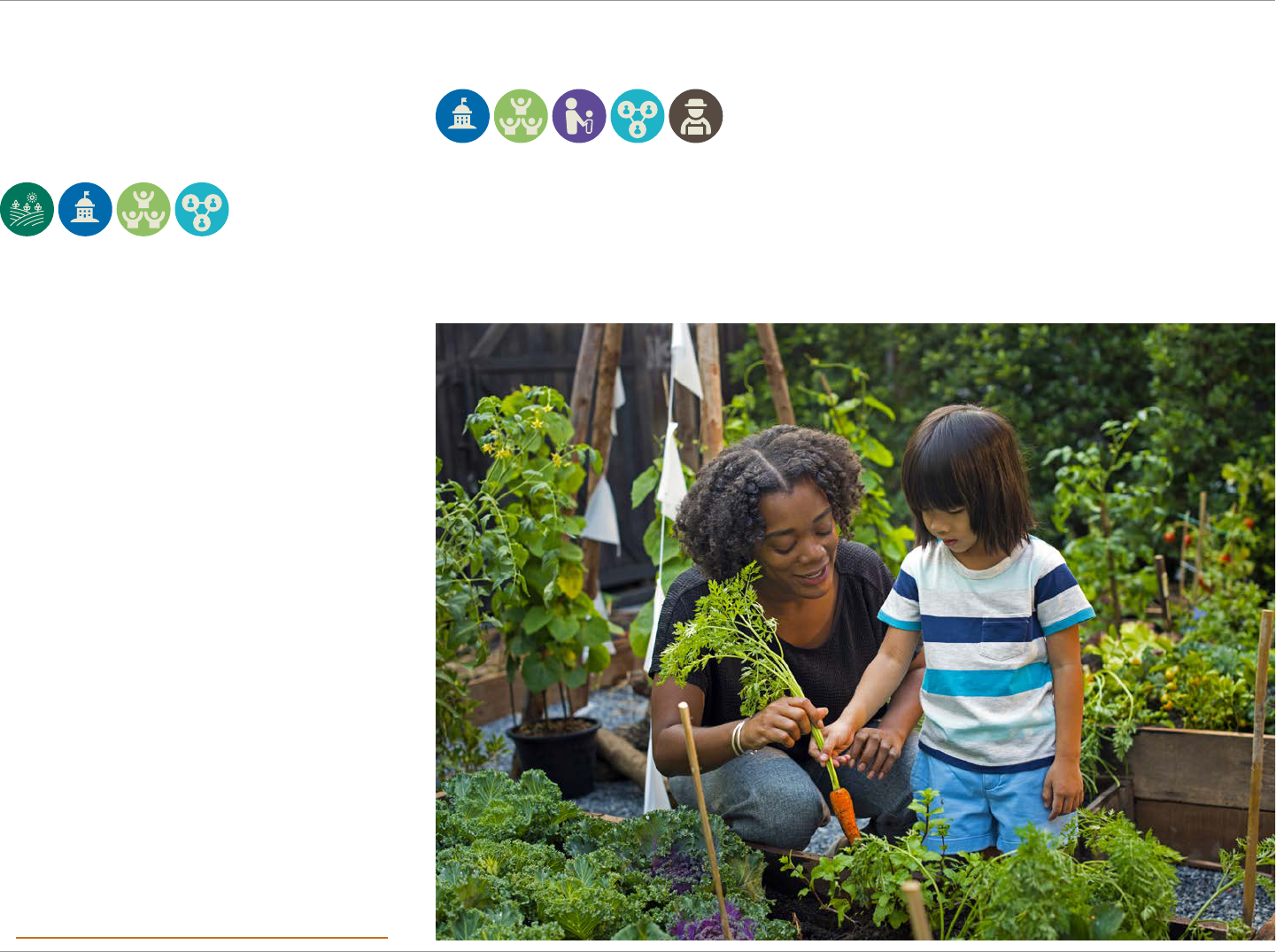
12 LEVERAGING CACFP FOR FARM TO EARLY CARE AND EDUCATION: GROWING WINS ACROSS EARLY CHILDHOOD AND FOOD SYSTEM SECTORS | JANUARY 2024 WWW.FRAC.ORG
SUPPORT CACFP PROVIDER FARM TO
ECE ACTIVITIES
7. INCREASE AWARENESS OF FARM TO ECE AND
THE ALLOWABLE USES OF CACFP TO SUPPORT IT,
INCLUDING INTEGRATING FARM TO ECE AND LOCAL
FOOD PROCUREMENT TRAINING INTO EXISTING
CACFP TRAINING AND SITE VISIT INFRASTRUCTURE
Many CACFP providers do not know about the
opportunity to conduct Farm to ECE activities and fewer
are aware of the many ways that CACFP can support
all three core elements of Farm to ECE activities as
described earlier in this report.
CACFP stakeholders should provide training and
distribute educational materials to inform child care
providers and the entities that serve them on the
opportunity to leverage CACFP for Farm to ECE.
Leveraging CACFP for Farm to ECE trainings can
be integrated into existing training processes and
infrastructure. To disseminate information broadly, state-
level CACFP and Farm to ECE websites should make
cross-references between CACFP and Farm to ECE.
Among CACFP state agency websites scanned, 27
percent (14) refer to Farm to ECE and five have specific
farm to CACFP information. A greater percentage of
state-level Farm to ECE websites refer to CACFP at
41 percent, but more can be done to cross-promote
CACFP and Farm to ECE as mutual beneficial eorts.
BARRIERS AND RECOMMENDATIONS FOR ACTION
8. FOSTER PEER AMBASSADORS, LEARNING GROUPS,
AND COMMUNITY COACHING AROUND CACFP AND
FARM TO ECE
Establishing peer ambassadors, learning groups, and
community coaching around CACFP and Farm to ECE
encourages knowledge sharing and best practice
dissemination, enhancing the overall eectiveness of
these initiatives and reducing startup costs like time spent
learning about the programs. Child care providers that are
already successfully implementing Farm to ECE activities
while leveraging CACFP can help other child care sites
that are interested in becoming involved by illustrating
the benefits and successes of the program, as well as
highlighting any knowledge, tools, or strategies that they
have developed over time. Peers can serve as an example
of what does and does not work and help illustrate how
the cost of local food fits within CACFP reimbursements.
To develop these types of initiatives, CACFP stakeholders
should embody cultural humility when partnering with
community organizations and child care providers, and
recognize that these relationships take time to build.
Individuals and organizations from the community
should be appropriately compensated for their time.
“I have trouble nding very clear,
concise guidance around CACFP and
Farm to ECE. It seems like if there was
something that pretty clearly laid out the
information like a one pager on gardens
and CACFP reimbursement, that states
could use to back up their own regulations
and programs that would be helpful.”
— Group Interview participant

13 LEVERAGING CACFP FOR FARM TO EARLY CARE AND EDUCATION: GROWING WINS ACROSS EARLY CHILDHOOD AND FOOD SYSTEM SECTORS | JANUARY 2024 WWW.FRAC.ORG
9. LEVERAGE CACFP STATE ADMINISTRATIVE
EXPENSE FUNDS TO PROVIDE TRAINING AND
TECHNICAL ASSISTANCE ON FARM TO ECE
Part of CACFP state administrative expense funds
should be allocated to support Farm to ECE
coordination, systems change, and other activities.
Funds can be used for state-level activities including:
` producing state-level Farm to ECE guidance materials
` employing Farm to ECE coordinators that provide
state-level training and technical assistance
` conducting statewide trainings and organizing
statewide meetings to disseminate program
information and encourage sharing of best practices
` collaborating on regional Farm to ECE eorts like
multistate conferences, training, and site visits
Group interview participants specifically emphasized a
need for a state-level farm to CACFP coordinator that
can help provide direct assistance and train-the-trainer
programming to help child care providers navigate the
process of utilizing CACFP for Farm to ECE activities
and providing answers to frequently asked questions.
Community organization partners can help advocate for
and supplement the capacity of SAE funds to provide
technical assistance on Farm to ECE activities for
CACFP providers.
10. SUPPORT LOCAL, STATELEVEL LOCAL FOOD
PROCUREMENT INCENTIVES FOR CACFP
CACFP stakeholders can provide evidence and
advocate for local- and state-level local food
procurement incentives that help encourage and
defray any additional procurement costs associated
with buying local foods. Local food purchasing
incentives often increase the reimbursement for local
BARRIERS AND RECOMMENDATIONS FOR ACTION
foods purchased with CACFP funds or CACFP meals
served that contain local foods. Multiple states have
already successfully funded and implemented local
purchasing incentive programs for CACFP providers
(Appendix 5).
11. DEVELOP AND DISTRIBUTE PROCESSES, GUIDES,
AND TOOLS THAT STREAMLINE THE USE OF CACFP
FOR FARM TO ECE ACTIVITIES
CACFP stakeholders can develop processes, guides,
and tools to help clarify and streamline the use of
CACFP for Farm to ECE activities. These resources
can be newly developed or modified from existing
materials. Group interview participants emphasized
that community-specific guides for procuring local
foods within CACFP guidelines are needed. Existing
materials should be more widely distributed, like
those found in Appendix 3, Practical Resources to
Help Support and Implement Farm to ECE Activities
“If there’s just more training at the
program level so that everyone is familiar
with these concepts and how to integrate
local food and Farm to ECE and CACFP
isn’t necessarily the special thing that
only certain people are doing or certain
people know about. It would be a dream
for every CACFP specialist to also be
informed, at least at a basic level of
Farm to ECE, so they could provide that
technical assistance.”
— Group Interview participant
While Leveraging CACFP. Tools and templates like the
Handwritten Receipt Template and Garden Harvest
Documentation Form Template available in this report
are examples of additional resources that can help
streamline the use of CACFP for Farm to ECE activities
for child care providers.

14 LEVERAGING CACFP FOR FARM TO EARLY CARE AND EDUCATION: GROWING WINS ACROSS EARLY CHILDHOOD AND FOOD SYSTEM SECTORS | JANUARY 2024 WWW.FRAC.ORG
BARRIERS AND RECOMMENDATIONS FOR ACTION
BOLSTER LOCAL FOOD SYSTEM
PARTNER ACCESS TO CACFP
MARKET CHANNELS
12. INVEST IN AND/OR DEVELOP SHARED CENTRAL
KITCHENS AND PURCHASING COOPERATIVES TO
SUPPORT LOCAL FOOD PRODUCERS’ ACCESS TO
CACFP MARKET CHANNELS
Group interview participants emphasized that for local
food purchasing in CACFP to be sustainable there
needs to be a system in place that does not depend
on individual’s institutional knowledge. Otherwise, if
those people move on to dierent jobs or roles, then
local food procurement will stop. CACFP and Farm to
ECE stakeholders can invest in and/or develop shared-
services models like central kitchens and purchasing
cooperatives between multiple CACFP providers to
help increase the sustainability of local food purchasing.
Centralized kitchens and purchasing cooperatives
can source ingredients from local farmers, prepare
meals, and deliver these meals for multiple CACFP
providers, increasing the volume of local foods sales
(making it more economical for food producers) and
ensuring delivery of local food products in compliance
with CACFP standards to the providers.
29
These shared
service models make it easier for CACFP providers
to participate in Farm to ECE because it means each
provider does not have to have all the preparation,
tools, and kitchen space to prepare unprocessed
foods. These models make supplying food to CACFP
providers more sustainable for food producers as well
because they receive a bigger purchase order for food.
Preparing local foods through a centralized kitchen
oers the additional benefit of removing the burden of
food preparation from centers and allows a third party
to ensure compliance with CACFP standards. Shared-
services approaches such as this, which connect
local farmers to CACFP providers through tailored
arrangements, are needed to ensure the sustainability
of many Farm to ECE programs.
“The problem with ECE buying is that
usually they cannot reach economies of
scale, so a lot of these things end up being
more work than they’re able to aord
and in an essence that’s racist because
those who are able to make time for that,
are the ones who get that benet. I think
it would be great if we could continue to
explore as a nation of seeing how federal
funding could support communities and
small businesses in this way, if we could
provide technical assistance to folks to
really understand how could they carve
out a business out of aggregation and
prepping and sponsorship to support
both the local farmer but also the local
[child care] business person.”
— Group Interview participant
13. CONNECT CACFP PROVIDERS AND FARMERS,
GARDENERS, OR OTHER FOOD SYSTEM PARTNERS
THAT MAY BE INTERESTED IN WORKING TOGETHER
CACFP stakeholders should actively foster relationships
between CACFP providers and farmers, gardeners, or
other food system partners through online directories,
match-making processes, networking events, and
regional hubs. Group interview participants discussed
the need for a directory for each state that lists all of
the food producers in each county and/or region that
have expressed interest in participating in Farm to ECE,
as well as the CACFP providers in the same area that
are currently participating or have expressed interest.
This resource would alleviate the burden on both sides
of making the connection.
“A network of sponsored farmers that
were working directly with CACFP, that
were already approved, would take out
some of the process of trying to gure
out which ones will work and which ones
will not. I think that would help support
the Farm to ECE process and link it with
CACFP creating a network.”
— Group Interview participant

15 LEVERAGING CACFP FOR FARM TO EARLY CARE AND EDUCATION: GROWING WINS ACROSS EARLY CHILDHOOD AND FOOD SYSTEM SECTORS | JANUARY 2024 WWW.FRAC.ORG
14. DEVELOP AND DISTRIBUTE RESOURCES TAILORED
TO FARMERS AND FOOD SYSTEM PARTNERS THAT
INFORM ON CACFP AND FARM TO ECE
There are few resources available that aim to educate
farmers, other local food producers, and their partners
about CACFP or Farm to ECE. CACFP and Farm to ECE
stakeholders should develop and distribute resources
that outline the basics of these initiatives and education
on how to connect with and/or supply food for CACFP
providers. Creating these resources addresses the lack
of information on where or how local food producers
can engage with CACFP child care providers and
reduces the time and capacity burden on the producer
to find and act on this information.
15. DEVELOP A LOCAL FOOD INFRASTRUCTURE
WITHIN TRADITIONAL FOOD RETAIL LOCATIONS AND
VENDORS
CACFP and Farm to ECE stakeholders should support
local food infrastructure to increase the availability
and accessibility of local foods at retail and vending
locations in the community via food hubs, farmers
markets, local vendors, and grocery stores. It may often
be easier for CACFP providers to access local foods
in these aggregate retail settings rather than directly
from a single local food producer and can reduce
purchasing burdens for both the food producer and the
child care provider.
30
To help CACFP providers select
local foods, stakeholders should encourage grocery
retailers and food vendors to stock and appropriately
label which foods are local.
BARRIERS AND RECOMMENDATIONS FOR ACTION
“We had a [grocery store] and they featured all the local farmers that
they got produce from and they would have a picture of the farmer
and that it was family owned and that was very helpful.”
— Group Interview participant

16 LEVERAGING CACFP FOR FARM TO EARLY CARE AND EDUCATION: GROWING WINS ACROSS EARLY CHILDHOOD AND FOOD SYSTEM SECTORS | JANUARY 2024 WWW.FRAC.ORG
Conclusion
L
everaging CACFP for Farm to ECE is a strategic
move to foster wins across early childhood and
food system sectors. This report underscores the
critical importance and vast potential of the Child
and Adult Care Food Program and Farm to Early
Care and Education in combating food insecurity
and its structural drivers. These initiatives are pivotal
not only for children and their families, but also for
child care providers and the broader community. The
synergistic relationship between CACFP and Farm
to ECE is evident and powerful and more must be
done to support access to and use of each. The
systems change recommendations outlined in this
report — including alterations to processes, policies,
regulations, environments, and resources — are
crucial in overcoming obstacles to accessing CACFP
and leveraging it for Farm to ECE activities.
The time is now for stakeholders across the
early childhood, nutrition program, and food
system sectors to act on these findings and
recommendations. By implementing these actionable
solutions, we can strengthen the impact of CACFP
and Farm to ECE, helping to ensure equitable access
to fresh, healthy foods for young children, and
supporting a more just and sustainable food system.
The collective eort of policy and regulation decision-
makers, state agencies, CACFP sponsors, child care
providers, local farmers and ranchers, regional food
hubs, and other food system sector partners is crucial
in this endeavor.
In embracing these recommendations, we have
the opportunity to transform the landscape of early
childhood nutrition and support the growth and
sustainability of local food systems. The evidence
and strategies laid out in this report provide a clear
pathway for eective solutions. By working together
and leveraging the strengths of CACFP and Farm
to ECE, we can build a healthier, more equitable,
and resilient food future for our children and the
communities they live in.

17 LEVERAGING CACFP FOR FARM TO EARLY CARE AND EDUCATION: GROWING WINS ACROSS EARLY CHILDHOOD AND FOOD SYSTEM SECTORS | JANUARY 2024 WWW.FRAC.ORG
APPENDICES
Appendix 1: Handwritten Receipt Template Appendix 2: Garden Harvest Documentation Form Template
Download a fillable PDF version of the
Garden Harvest Documentation Form template here.
Download an editable Word version of the
Garden Harvest Documentation Form template here.
Download a fillable PDF version
of the receipt template here.
Download an editable Word version
of the receipt template here.
Sales Receipt
Date of Purchase*:________________
Vendor/Farmer:
Name*:____________________________________
Street Address:______________________________
City/State/ZIP: ______________________________
Sold To:
Name:_____________________________________
Street Address:______________________________
City/State/ZIP: ______________________________
ITEM DESCRIPTION
QUANTITY*
PRICE PER UNIT*
LINE TOTAL*
SUBTOTAL
SALES TAX
TOTAL*
*Required for CACFP Reimbursement
Garden Harvest Documentation Form
Provider Information
Sponsor/Ins�tu�on Name:_________________________________
Site/Facility Name:______________________________________________
Provider Contact Informa�on:_____________________________________
Garden Harvest and Use Information
Date
Food was
Harvested
Description of Food Harvested
(Please document each type of food
harvested separately by harvest date)
Amount
(by Weight
or Volume)
Meal Service Information
Date of Meal Service
when harvested food
was used
Meal Service Type
that included the
harvested food

18 LEVERAGING CACFP FOR FARM TO EARLY CARE AND EDUCATION: GROWING WINS ACROSS EARLY CHILDHOOD AND FOOD SYSTEM SECTORS | JANUARY 2024 WWW.FRAC.ORG
Appendix 3: Practical Resources to Help Support and Implement
Farm to ECE Activities While Leveraging CACFP
Appendix 4: Semi-Structured Group Interview Guide
National Organization Websites and Resource Directories
` National Farm to School Network (NFSN)
» Farm to Early Care and Education landing page
» State Resource Directory of Farm to ECE Materials and Guides
» Resource Database
` Centers for Disease Control and Prevention Advancing Farm to ECE webpage
` USDA Farm to ECE Resources
Starting Farm to ECE Activities
` Getting Started With Farm to Early Care and Education, NFSN
` Introducción A De La Granja Al Pre-Escolar, NFSN
` Farm to Early Childhood Programs: A Step-By-Step Guide, MSU Center for Regional
Food Systems
` Farm to Preschool: Local Food and Learning in Early Child Care and Education
Settings, USDA
` A Roadmap for Farm to Early Care and Education, NFSN
Procuring Local Foods With CACFP
` Procuring Local Foods for Child Nutrition Programs, USDA
» “Beyond Lunch: Buying Local Foods for Summer and Child Care Programs”
` Local Procurement for Child Care Centers, NFSN
` Local Purchasing for Family Child Care Providers, NFSN
` Food Buying Guide for Child Nutrition Programs, USDA
` Local Food Directories, USDA
Policy and USDA Guidance on Leveraging CACFP for Farm to ECE
` Local Foods in CACFP
` Use of State Administrative Expense (SAE) Funds to Support Farm to ECE
` Procuring Local Meat, Poultry, Game and Eggs, for Child Nutrition Programs
` Financial Management CACFP — FNS Instruction 796-2, Revision 4
` USDA Geographic Preference Guide
1. What is your experience with the Child and Adult Care Food Program (CACFP)?
a. How would you describe the user friendliness of CACFP?
b. For child care providers, what are the barriers to accessing the program or the issues with
participating?
c. Have there been any improvements or updates in the program that have made it more
accessible and/or approachable?
2. What is your experience with CACFP as it relates to Farm to ECE?
a. What ways have you seen CACFP used to support Farm to ECE? What ways would you like
CACFP to be able to be used to support Farm to ECE?
i. How easy or dicult is it to use CACFP for Farm to ECE activities?
ii. What are dierences in CACFP use for Farm to ECE activities based on their geographic
location in the state, i.e. urban v rural areas?
b. What lessons have your organization, agency, grantees, providers, clients, farmers, or
partners, learned regarding CACFP and Farm to ECE?
c. How can we leverage the funding and power of CACFP to support the work of building
equity into the ECE and food systems?
3. What state or local supports, resources, practices, or policies help providers in navigating
CACFP and/or leveraging CACFP for Farm to ECE?
4. What training or resources would be useful to you and partners to be able to use CACFP
for Farm to ECE activities?
a. What training and resources do you have to share that would help other partners?
5. As we enter year four of the COVID-19 pandemic and begin to find the “new normal”
are there things that have changed because of pandemic-era policies that have helped
improve CACFP and/or leveraging CACFP for Farm to ECE?
6. What policies or rules impact use of CACFP for Farm to ECE? What improvements would
you recommend?
APPENDICES
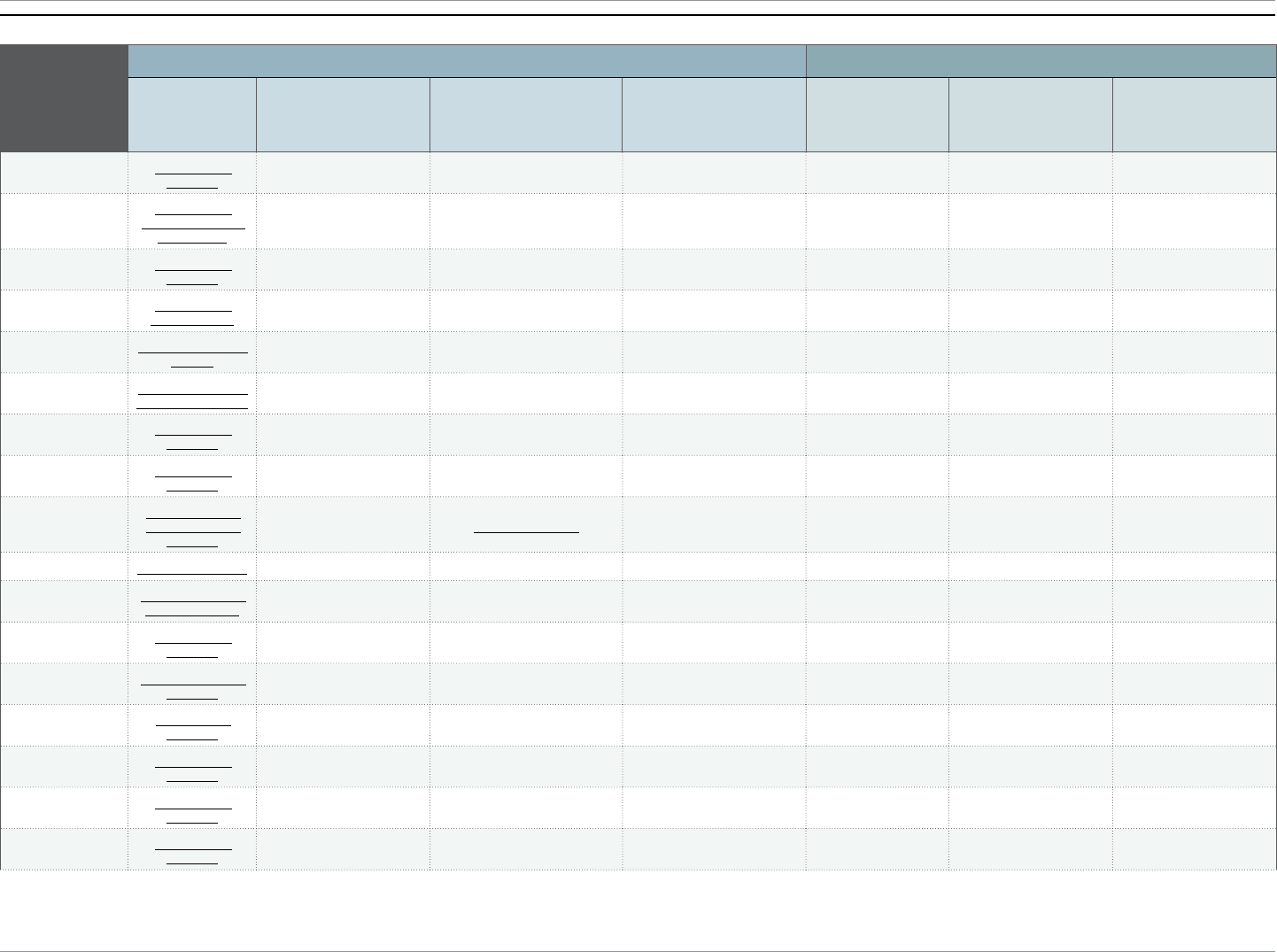
19 LEVERAGING CACFP FOR FARM TO EARLY CARE AND EDUCATION: GROWING WINS ACROSS EARLY CHILDHOOD AND FOOD SYSTEM SECTORS | JANUARY 2024 WWW.FRAC.ORG
State
CACFP State Agency Website Characteristics and Survey Responses State-Level Farm to ECE Website Characteristics
CACFP State Agency
Department Website
CACFP State Agency Website
Mentions Farm to ECE*
State Funds Additional Meal
Reimbursement for Local Food
Procurement in CACFP Settings*
CACFP State Agency Utilizes
CACFP Administrative Funds to
Support Farm to ECE Activities**
State-Level Farm to ECE
Website Exists*
State-Level Farm to ECE
Website Mentions CACFP*
State CACFP or Farm to ECE
Site Provides Resources
for Farmers or Other Food
System Partners*
Alabama
Department of
Education
— — Unsure Yes Yes —
Alaska
Department of
Education and Early
Development
— — Unsure Yes Yes Yes
Arizona
Department of
Education
— — Yes Yes — —
Arkansas
Department of
Human Services
— — Yes Yes — —
California
Department of Social
Services
Yes*** — Yes Yes Yes Yes
Colorado
Department of Public
Health & Environment
Yes — No response Yes Yes Yes
Connecticut
Department of
Education
— — Unsure Yes — —
Delaware
Department of
Education
— — Yes Yes — —
District of Columbia
Oce of the State
Superintendent of
Education
— Yes, Healthy Tots Act Yes Yes — —
Florida
Department of Health — — Yes — — —
Georgia
Department of Early
Care and Learning
Yes — Yes Yes Yes —
Hawaii
Department of
Education
— — Yes Yes — —
Idaho
State Department of
Education
— — Unsure Yes — —
Illinois
State Board of
Education
— — Unsure Yes Yes —
Indiana
Department of
Education
— — Yes Yes — —
Iowa
Department of
Education
Yes*** — Yes Yes Yes —
Kansas
Department of
Education
— — Yes — — —
Appendix 5: Characteristics of State-Level CACFP and Farm to ECE Websites and Practices
APPENDICES
*Source: Food Research & Action Center analysis of a scan of CACFP state agency websites and state-level Farm to ECE websites in spring 2023.
**Source: Food Research & Action Center analysis of a 2022 survey of CACFP state agency directors.
***CACFP state agency website has a farm to CACFP section or webpage.

20 LEVERAGING CACFP FOR FARM TO EARLY CARE AND EDUCATION: GROWING WINS ACROSS EARLY CHILDHOOD AND FOOD SYSTEM SECTORS | JANUARY 2024 WWW.FRAC.ORG
State
CACFP State Agency Website Characteristics and Survey Responses State-Level Farm to ECE Website Characteristics
CACFP State Agency
Department Website
CACFP State Agency Website
Mentions Farm to ECE*
State Funds Additional Meal
Reimbursement for Local Food
Procurement in CACFP Settings*
CACFP State Agency Utilizes
CACFP Administrative Funds to
Support Farm to ECE Activities**
State-Level Farm to ECE
Website Exists*
State-Level Farm to ECE
Website Mentions CACFP*
State CACFP or Farm to ECE
Site Provides Resources
for Farmers or Other Food
System Partners*
Kentucky
Department of
Education
— — Yes Yes — Yes
Louisiana
Department of
Education
Yes — Yes Yes Yes Yes
Maine
Department of
Education
— — No response Yes Yes —
Maryland
Department of
Education
— — No response Yes — Yes
Massachusetts
Department of
Elementary and
Secondary Education
— — Yes Yes — —
Michigan
Department of
Education
Yes
Yes, 10 Cents a Meal for
Michigan’s Kids & Farms
Yes Yes Yes —
Minnesota
Department of
Education
— — No response Yes — —
Mississippi
Department of
Education
— — No response Yes — Yes
Missouri
Department of Health
and Senior Services
— — No Yes Yes Yes
Montana
Department of Public
Health and Human
Services
— — No Yes Yes —
Nebraska
Department of
Education
Yes — No response Yes Yes —
Nevada
Department of
Agriculture
Yes — No — — Yes
New Hampshire
Department of
Education
— — No Yes — Yes
New Jersey
Department of
Agriculture
Yes — No Yes Yes Yes
New Mexico
Children Youth and
Families Department
— Yes, New Mexico Grown Yes — — —
New York
Department of Health — — Yes Yes Yes —
North Carolina
Department of Health
and Human Services
Yes*** — Yes Yes Yes —
Appendix 5: Characteristics of State-Level CACFP and Farm to ECE Websites and Practices (continued)
APPENDICES
*Source: Food Research & Action Center analysis of a scan of CACFP state agency websites and state-level Farm to ECE websites in spring 2023.
**Source: Food Research & Action Center analysis of a 2022 survey of CACFP state agency directors.
***CACFP state agency website has a farm to CACFP section or webpage.
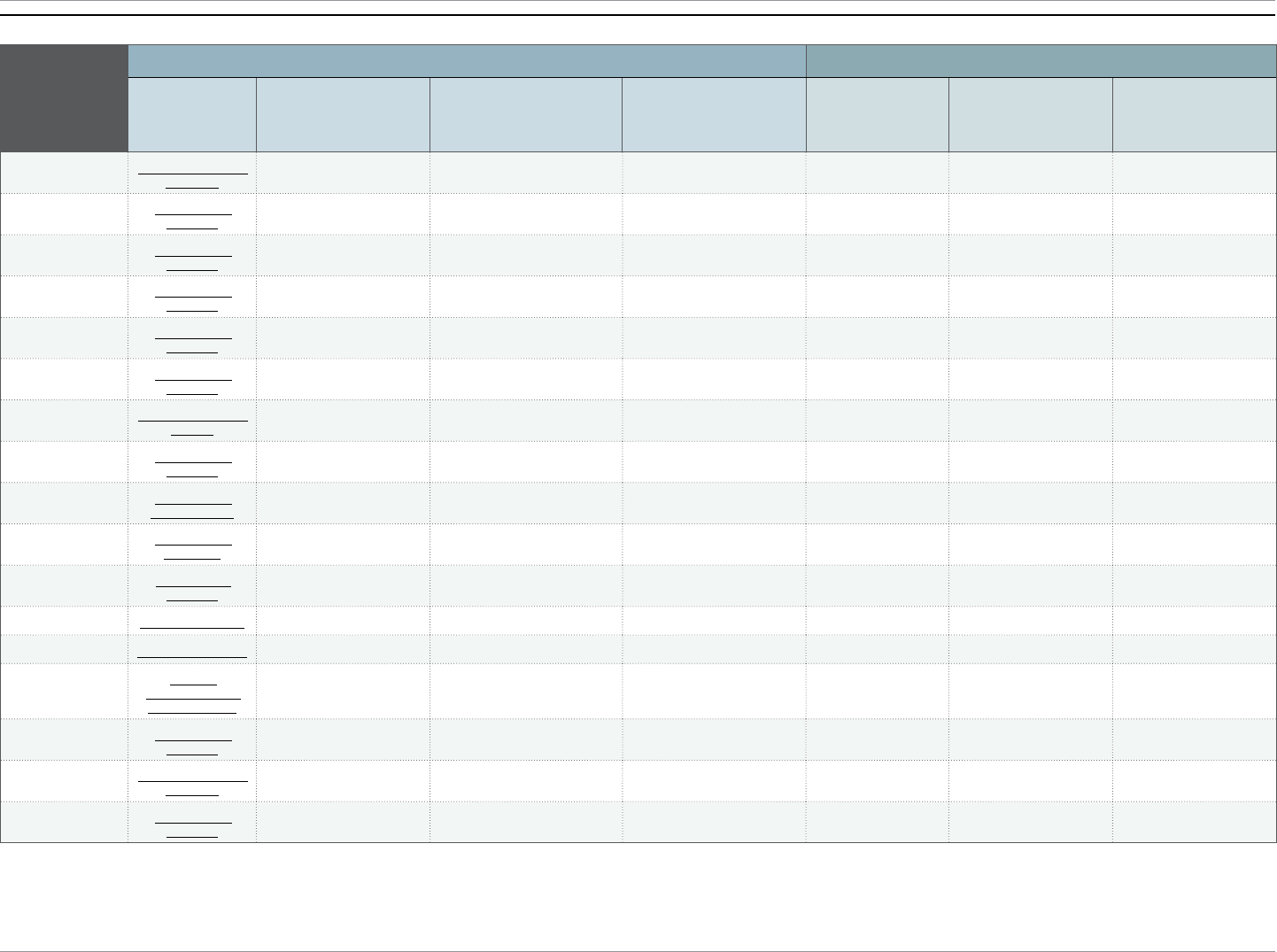
21 LEVERAGING CACFP FOR FARM TO EARLY CARE AND EDUCATION: GROWING WINS ACROSS EARLY CHILDHOOD AND FOOD SYSTEM SECTORS | JANUARY 2024 WWW.FRAC.ORG
Appendix 5: Characteristics of State-Level CACFP and Farm to ECE Websites and Practices (continued)
State
CACFP State Agency Website Characteristics and Survey Responses State-Level Farm to ECE Website Characteristics
CACFP State Agency
Department Website
CACFP State Agency Website
Mentions Farm to ECE*
State Funds Additional Meal
Reimbursement for Local Food
Procurement in CACFP Settings*
CACFP State Agency Utilizes
CACFP Administrative Funds to
Support Farm to ECE Activities**
State-Level Farm to ECE
Website Exists*
State-Level Farm to ECE
Website Mentions CACFP*
State CACFP or Farm to ECE
Site Provides Resources
for Farmers or Other Food
System Partners*
North Dakota
Department of Public
Instruction
— — No — — —
Ohio
Department of
Education
— — No Yes — Yes
Oklahoma
Department of
Education
— — Unsure Yes — Yes
Oregon
Department of
Education
Yes — No Yes — —
Pennsylvania
Department of
Education
— — Unsure Yes Yes Yes
Rhode Island
Department of
Education
— — No — — —
South Carolina
Department of Social
Services
— — Yes Yes — Yes
South Dakota
Department of
Education
— — Unsure Yes — —
Tennessee
Department of
Human Services
— — Unsure — — —
Texas
Department of
Agriculture
— — Yes — — —
Utah
State Board of
Education
— — Yes Yes — —
Vermont
Agency of Education — — No response Yes Yes —
Virginia
Department of Health Yes*** — Yes Yes Yes —
Washington
Oce of
Superintendent of
Public Instruction
Yes*** — No Yes Yes —
West Virginia
Department of
Education
— — No — — —
Wisconsin
Department of Public
Instruction
Yes — No Yes Yes Yes
Wyoming
Department of
Education
— — Yes — — —
APPENDICES
*Source: Food Research & Action Center analysis of a scan of CACFP state agency websites and state-level Farm to ECE websites in spring 2023.
**Source: Food Research & Action Center analysis of a 2022 survey of CACFP state agency directors.
***CACFP state agency website has a farm to CACFP section or webpage.

22 LEVERAGING CACFP FOR FARM TO EARLY CARE AND EDUCATION: GROWING WINS ACROSS EARLY CHILDHOOD AND FOOD SYSTEM SECTORS | JANUARY 2024 WWW.FRAC.ORG
1 National Farm to School Network and Michigan State University Center for Regional
Food Systems. (2022). 2021 National Farm to Early Care and Education Survey.
Available at: https://www.farmtoschool.org/resources-main/2021-national-farm-to-early-
care-and-education-survey.
2 National Farm to School Network and Michigan State University Center for Regional
Food Systems. (2022). 2021 National Farm to Early Care and Education Survey.
Available at: https://www.farmtoschool.org/resources-main/2021-national-farm-to-early-
care-and-education-survey.
3 Farm to Institution New England. (2023). Farm to Early Childhood in New England:
New Report Outlines Current Landscape and Opportunities. Available at: https://
farmtoinstitution.org/blog/farm-early-childhood-report.
4 Every Child Thrives. (2021). Resources to grow the farm to early care and education
movement. W.K. Kellogg Foundation. Available at: https://everychildthrives.com/
resources-to-grow-the-farm-to-early-care-and-education-movement.
5 Taniguchi T, Haslam A, Sun W, Sisk M, Hayman J, Jernigan VBB. (2022). Impact of a
Farm-to-School Nutrition and Gardening Intervention for Native American Families
from the FRESH Study: A Randomized Wait-List Controlled Trial. Nutrients. 14(13):2601.
Available at: https://doi.org/10.3390/nu14132601.
6 Betty T. Izumi, Cara L. Eckhardt, Jennifer A. Hallman, Katherine Herro, Dawn A. Barberis.
(2015). Harvest for Healthy Kids Pilot Study: Associations between Exposure to a
Farm-to-Preschool Intervention and Willingness to Try and Liking of Target Fruits and
Vegetables among Low-Income Children in Head Start. Journal of the Academy of
Nutrition and Dietetics. Volume 115, Issue 12. Pages 2003–2013. ISSN 2212–2672.
Available at: https://www.jandonline.org/article/S2212-2672(15)01249-6/pdf.
7 U.S. Department of Agriculture Food and Nutrition Service. (2015). Local Foods in the
Child and Adult Care Food Program with Questions and Answers. Available at: https://
fns-prod.azureedge.us/sites/default/files/f2s/CACFP11_2015_Local%20Foods%20in%20
CACFP_03%2013%202015.pdf.
8 Food Research and Action Center and Hunger Solutions Consulting analysis of U.S.
Department of Agriculture Food and Nutrition Service July 2023 Keydata Report.
Available at: https://www.fns.usda.gov/data/july-2023-keydata-report.
9 Gurzo K, Lee DL, Ritchie K, et al. (2020). Child care sites participating in the
federal child and adult care food program provide more nutritious foods and
beverages. Journal of Nutrition Education and Behavior. 52(7):697–704. doi:10.1016/j.
Jneb.2020.02.009. Available at: https://pubmed.ncbi.nlm.nih.gov/32268971.
10 Chriqui JF, Leider J, Schermbeck RM, Sanghera A, Pugach O. (2020). Changes in
Child and Adult Care Food Program (CACFP) Practices at Participating Childcare
and Education Centers in the United States Following Updated National Standards,
2017–2019. Nutrients. 12(9):2818. Available at: https://www.ncbi.nlm.nih.gov/pmc/
articles/PMC7551123.
11 Food Research & Action Center. (2017). Hunger and Health — The Role of the Federal
Child Nutrition Programs in Improving Health and Well-Being. Available at: https://frac.
org/research/resource-library/hunger-health-role-federal-child-nutrition-programs-
improving-health-well.
12 Food Research & Action Center. (2020). FACTS: The child and adult care food program.
Available at: https://frac.org/wp-content/uploads/cacfp-fact-sheet.pdf.
13 Edwards, C. P., Knoche, L., Raikes, A., Raikes, H., Torquati, J., Wilcox, B., & Christensen,
L. (2002). Child Care Characteristics and Quality in Nebraska. Prepared for the
Midwest Child Care Research Consortium. Available at: https://digitalcommons.unl.edu/
cgi/viewcontent.cgi?article=1010&context=ccflpubs.
14 Heflin, C., Arteaga, I., & Gable, S. (2015). The Child and Adult Care Food Program and
food insecurity. Social Service Review, 89(1), 77–98. doi10.1086/679760. Available at:
https://www.journals.uchicago.edu/doi/abs/10.1086/679760?mobileUi=0&journalCode=ssr.
15 Korenman S, Abner KS, Kaestner R, Gordon RA. (2013). The Child and Adult Care Food
Program and the Nutrition of Preschoolers. Early Child Res Q. 28(2):325–336. doi:
10.1016/j.ecresq.2012.07.007. Available at: https://www.ncbi.nlm.nih.gov/pmc/articles/
PMC3653583/.
16 Gordon, R. A., Kaestner, R., Korenman, S., & Abner, K. (2010). The Child and Adult
Care Food Program: Who is Served and What are Their Nutritional Outcomes? NBER
Working Paper, 16148. doi 10.3386/w16148. Available at: https://www.nber.org/
papers/w16148.
17 Liu, S. T., Graagino, C. L., Leser, K. A., Trombetta, A. L., & Pirie, P. L. (2016). Obesity
prevention practices and policies in child care settings enrolled and not enrolled in
the Child and Adult Care Food Program. Maternal and Child Health Journal, 20(9),
1933–1939. doi: 10.1007/s10995-016-2007-z. Available at: https://pubmed.ncbi.nlm.nih.
gov/27112556/.
18 Lumeng, J. C., Kaciroti, N., Sturza, J., Krusky, A. M., Miller, A. L., Peterson, K. E., Lipton,
R., & Reischl, T. M. (2015). Changes in body mass index associated with head start
participation. Pediatrics, 135(2), e449–e456. doi: 10.1542/peds.2014-1725. Available at:
https://pubmed.ncbi.nlm.nih.gov/25583912.
19 Gayman, A., Ettinger de Cuba, S., March, E., Cook, J. T., Coleman, S., & Frank, D. A.
(2010). Child Care Feeding Programs Support Young Children’s Healthy Development.
Boston, MA: Children’s HealthWatch. Available at: https://childrenshealthwatch.org/
wp-content/uploads/CACFP_brief_January2010.pdf.
20 National Farm to School Network. (2021). Farm to Early Care and Education: Cultivating
healthy habits for our littlest eaters. Available at https://www.farmtoschool.org/our-
work/early-care-and-education.
21 U.S. Department of Agriculture Food and Nutrition Service. (2023). Financial
Management CACFP — FNS Instruction 796-2, Revision 4. Available at: https://www.fns.
usda.gov/cacfp/fns-instruction-796-2-revision-4.
22 U.S. Department of Agriculture Food and Nutrition Service. (2011). Final rule on
Geographic Preference Option for the Procurement of Unprocessed Agricultural
Products in Child Nutrition Programs. 76 FR 22603. Document number: 2011–9843.
Available at: https://www.federalregister.gov/d/2011-9843/p-60.
23 U.S. Department of Agriculture Food and Nutrition Service. (2015). Local Foods in the
Child and Adult Care Food Program with Questions and Answers. Available at https://
fns-prod.azureedge.us/sites/default/files/f2s/CACFP11_2015_Local%20Foods%20in%20
CACFP_03%2013%202015.pdf.
24 U.S. Department of Agriculture Food and Nutrition Service. (2015). Local Foods in the
Child and Adult Care Food Program with Questions and Answers. Available at https://
fns-prod.azureedge.us/sites/default/files/f2s/CACFP11_2015_Local%20Foods%20in%20
CACFP_03%2013%202015.pdf.
25 U.S. Department of Agriculture Food and Nutrition Service. (2014). Farm to School and
School Garden Expenses. Available at: https://www.fns.usda.gov/cn/farm-school-and-
school-garden-expenses.
26 U.S. Department of Agriculture Food and Nutrition Service. (2015). Local Foods in the
Child and Adult Care Food Program with Questions and Answers. Available at https://
fns-prod.azureedge.us/sites/default/files/f2s/CACFP11_2015_Local%20Foods%20in%20
CACFP_03%2013%202015.pdf.
27 U.S. Department of Agriculture Food and Nutrition Service. (2014). Farm to School and
School Garden Expenses. Available at: https://www.fns.usda.gov/cn/farm-school-and-
school-garden-expenses.
28 U.S. Department of Agriculture Food and Nutrition Service. (2015). Questions and
Answers Regarding the Use of State Administrative Expense (SAE) Funds and State
Administrative Funds (SAF) for Farm to School Related Expenses. Available at: https://
www.fns.usda.gov/cn/qas-regarding-use-sae-funds-and-sa-funds-farm-school-related-
expenses.
29 Bloom, D., Boys, K., Shisler, R. C., Dunning, R., Hundley, C., & Yates, D. (2022).
Exploring Models of Local Food Procurement in Farm to Early Care and Education
Programs. Journal of Human Sciences and Extension. 10(1), 3. Available at: https://doi.
org/10.54718/CONI3088.
30 Rutz, J., Bloom, J., Schroeder-Moreno, M., Gunter, C., (2018). Farm to Childcare:
An Analysis of Social and Economic Values in Local Food Systems. Journal of
Agriculture, Food Systems, and Community Development. 1–17. Available at: https://doi.
org/10.5304/jafscd.2018.083.004.
ENDNOTES


